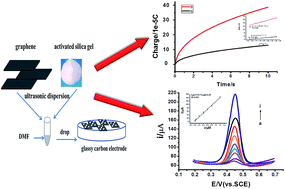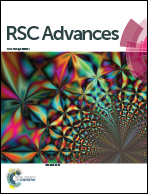An electrochemical sensor for the sensitive detection of rutin based on a novel composite of activated silica gel and graphene
Abstract
In this paper, a novel activated silica gel (ASiG)–graphene (G) composite was initially fabricated via a simple sonication-induced assembly and used as the substrate material to prepare an electrochemical sensor (ASiG/G/GCE) for the sensitive determination of rutin. Morphology and electrochemical properties of the composite were investigated by transmission electron microscopy (TEM), chronocoulometry, electrochemical impedance spectroscopy (EIS), cyclic voltammetry (CV) and differential pulse voltammetry (DPV). Experimental results revealed that the ASiG/G composite induced a remarkable increase of the redox currents of rutin, which could be attributed to the high surface area and excellent electric conductivity of G, as well as the strong accumulation efficiency of ASiG toward rutin. The peak current from DPV is linearly dependent on the rutin concentration in a range of 0.001 to 1.2 μmol L−1 with a detection limit of 3.3 nmol L−1. The ASiG/G/GCE also exhibited good selectivity and acceptable reproducibility. Moreover, the ASiG/G/GCE was successfully applied to the fast determination of rutin in medicine tablets and human plasma with satisfactory recoveries. Therefore, the present work offers a new way to broaden the analytical applications of functionalized graphene in pharmaceutical research.


 Please wait while we load your content...
Please wait while we load your content...